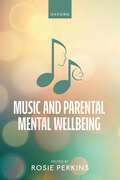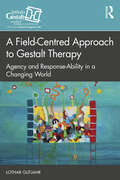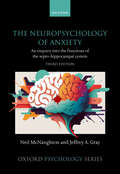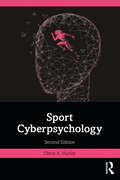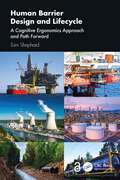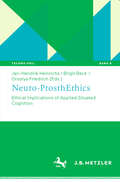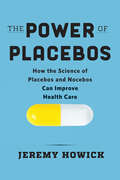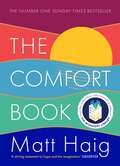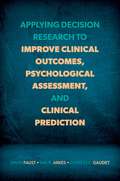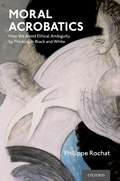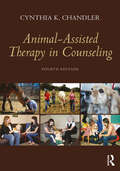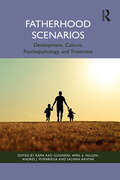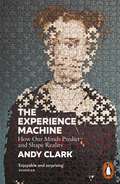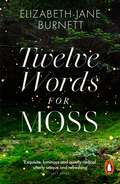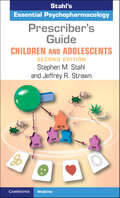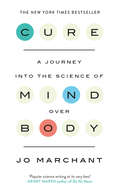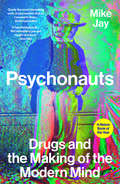- Table View
- List View
Music and Parental Mental Wellbeing
by Rosie PerkinsThere is compelling evidence that music can enhance parental wellbeing, yet to date there have been few attempts to bring together current endeavours in the field. Music and Parental Mental Wellbeing provides readers from music, health, and beyond, with a new and comprehensive opportunity to consider how music can support parental mental wellbeing. Drawing on recent ground-breaking practice, research, and evaluation the book illuminates how music can support mental wellbeing in pregnancy and the postnatal period, childbirth and perinatal hospital settings, and in the early years. Each chapter provides introductory context, describes the relevant musical practice, consider the intersections with parental wellbeing, and end with implications for practice and key take-aways for the reader. With an interdisciplinary and international team of authors, including music and health practitioners, experts by experience, and researchers, this book explores and establishes the role of music, in its many forms, in supporting and enhancing parental mental wellbeing.
Music and Parental Mental Wellbeing
by Rosie PerkinsThere is compelling evidence that music can enhance parental wellbeing, yet to date there have been few attempts to bring together current endeavours in the field. Music and Parental Mental Wellbeing provides readers from music, health, and beyond, with a new and comprehensive opportunity to consider how music can support parental mental wellbeing. Drawing on recent ground-breaking practice, research, and evaluation the book illuminates how music can support mental wellbeing in pregnancy and the postnatal period, childbirth and perinatal hospital settings, and in the early years. Each chapter provides introductory context, describes the relevant musical practice, consider the intersections with parental wellbeing, and end with implications for practice and key take-aways for the reader. With an interdisciplinary and international team of authors, including music and health practitioners, experts by experience, and researchers, this book explores and establishes the role of music, in its many forms, in supporting and enhancing parental mental wellbeing.
A Field-Centred Approach to Gestalt Therapy: Agency and Response-ability in a Changing World (The Gestalt Therapy Book Series)
by Lothar GutjahrIn Gestalt therapy, sociological, political, and economic research is often neglected or ignored. Drawing on analyses about current societal conditions, this book considers that there is no such thing as a ‘postmodern’ therapy and offers a new approach to Gestalt therapy.Gestalt therapy is still currently based on the Cartesian worldview, even if relational approaches are in search for an ‘in-between’. The author’s approach of Gestalt therapy is based on an idea by the founders: “Contact is the first reality” – so the field coemerges and coexists with individuals’ perceptions providing specific conditions, demands, limitations and opportunities. An individual’s field is not an afterthought established by the perspective of the first-person-singular (i.e. individuals) but a ‘conditio sine qua non’. Gutjahr reflects on both theoretical and practical aspects of the field’s many processes of resonance. Putting the field consistently at the centre of his approach, the author describes the main tenets expanding on previous versions of Gestalt therapy.This important new book is at the cutting edge of the current discussion of relational and field-oriented approaches to Gestalt therapy, and will be of particular interest to practitioners of Gestalt therapy, psychotherapists, phenomenologists, as well as theorists of philosophy, sociology and therapy.
The Neuropsychology of Anxiety: An enquiry into the functions of the septo-hippocampal system (Oxford Psychology Series)
by Prof Neil McNaughton Prof Jeffrey A. GrayThe Neuropsychology of Anxiety first appeared in 1982 as the first volume in the Oxford Psychology Series, and it quickly established itself as a classic work in the psychology and neuroscience literature. It presented an innovative, and at times controversial, theory of anxiety and the brain systems, especially the septo-hippocampal system, that subserve it. This completely updated and revised third edition provides a further updated theory of septo hippocampal function combined with an improved understanding of anxiety. The book includes a new chapter on prefrontal cortex integrating frontal and hippocampal views of anxiety, as well as an extensively modified chapter on personality providing a new basis for further developments of Reinforcement Sensitivity Theory. In addition, numerous figures have been fully updated and converted to colour to support the text. This book is essential for postgraduate students and researchers in experimental psychology and neuroscience, as well as for all clinical psychologists and psychiatrists.
A Field-Centred Approach to Gestalt Therapy: Agency and Response-ability in a Changing World (The Gestalt Therapy Book Series)
by Lothar GutjahrIn Gestalt therapy, sociological, political, and economic research is often neglected or ignored. Drawing on analyses about current societal conditions, this book considers that there is no such thing as a ‘postmodern’ therapy and offers a new approach to Gestalt therapy.Gestalt therapy is still currently based on the Cartesian worldview, even if relational approaches are in search for an ‘in-between’. The author’s approach of Gestalt therapy is based on an idea by the founders: “Contact is the first reality” – so the field coemerges and coexists with individuals’ perceptions providing specific conditions, demands, limitations and opportunities. An individual’s field is not an afterthought established by the perspective of the first-person-singular (i.e. individuals) but a ‘conditio sine qua non’. Gutjahr reflects on both theoretical and practical aspects of the field’s many processes of resonance. Putting the field consistently at the centre of his approach, the author describes the main tenets expanding on previous versions of Gestalt therapy.This important new book is at the cutting edge of the current discussion of relational and field-oriented approaches to Gestalt therapy, and will be of particular interest to practitioners of Gestalt therapy, psychotherapists, phenomenologists, as well as theorists of philosophy, sociology and therapy.
Sport Cyberpsychology
by Olivia A. HurleyThe new edition of Sport Cyberpsychology is the only textbook in this field that provides a detailed overview of theories, concepts and research findings specifically related to the discipline of sport cyberpsychology. Post-pandemic, this new edition explores the vast psychological impact technology has on athletes' thoughts, emotions and preparations for their sport, as well as the role technology plays in sport consulting, officiating and social interactions. It covers topics that include performance-enhancing technologies, social media use by athletes and sport personnel (e.g., sport officials) and the role of technology in sport psychology consulting. Problematic behaviours athletes may encounter or engage in within the online world, such as their experiences with cyberbullying and online gambling are also discussed.This second edition includes a review of the latest esports research and activities that are gaining global popularity. The final chapter presents some new research horizons in the field of sport cyberpsychology. The book includes a range of helpful features including case studies, open-ended discussion questions, suggestions for future research studies and extensive reference lists.Accessibly written, this edition of Sport Cyberpsychology offers a one-stop, engaging resource for students and instructors alike. It is important reading for students of sport psychology, cyberpsychology, sport coaching, sport officiating and sport technology, as well as coaches, traditional athletes, esports athletes, sport scientists and performers in areas such as dance, the arts, the military and medicine.
Sport Cyberpsychology
by Olivia A. HurleyThe new edition of Sport Cyberpsychology is the only textbook in this field that provides a detailed overview of theories, concepts and research findings specifically related to the discipline of sport cyberpsychology. Post-pandemic, this new edition explores the vast psychological impact technology has on athletes' thoughts, emotions and preparations for their sport, as well as the role technology plays in sport consulting, officiating and social interactions. It covers topics that include performance-enhancing technologies, social media use by athletes and sport personnel (e.g., sport officials) and the role of technology in sport psychology consulting. Problematic behaviours athletes may encounter or engage in within the online world, such as their experiences with cyberbullying and online gambling are also discussed.This second edition includes a review of the latest esports research and activities that are gaining global popularity. The final chapter presents some new research horizons in the field of sport cyberpsychology. The book includes a range of helpful features including case studies, open-ended discussion questions, suggestions for future research studies and extensive reference lists.Accessibly written, this edition of Sport Cyberpsychology offers a one-stop, engaging resource for students and instructors alike. It is important reading for students of sport psychology, cyberpsychology, sport coaching, sport officiating and sport technology, as well as coaches, traditional athletes, esports athletes, sport scientists and performers in areas such as dance, the arts, the military and medicine.
Human Barrier Design and Lifecycle: A Cognitive Ergonomics Approach and Path Forward
by Tom ShephardA common source of failure in a human‑dependent barrier or safety critical task is a designed‑in mismatch error. The mismatch is a cognitive demand that exceeds the human capability to reliably and promptly respond to that demand given the plausible situations at that moment. Demand situations often include incomplete information, increased time pressures, and challenging environments. This book presents innovative solutions to reveal, prevent, and mitigate these and many other cognitive‑type errors in barriers and safety critical tasks. The comprehensive model and methodologies also provide insight into where and to what extent these barriers and task types may be significantly underspecified and the potential consequences.This title presents a new and comprehensive prototype design and lifecycle model specific to human‑dependent barriers and safety critical tasks. Designed to supplement current practice, the model is fully underpinned by cognitive ergonomics and cognitive science. The book also presents a compelling case for why a new global consensus standard specific to human‑dependent barriers is needed. Taking a novel approach, it presents its suggested basis, framing, and content. Both solutions seek to redress deficiencies in global regulations, standards, and practice. The model is guided by industry recommendations and best practice guidance and solutions from globally recognized experts. Its processes are fully explained and supported by examples, analysis, and well‑researched background materials. Real‑life case studies from offshore oil and gas, chemical manufacturing, transmission pipelines, and product storage provide further insight into how overt and latent design errors contributed to barrier degradation and failure and the consequence of those errors.An essential and fascinating read for professionals, Human Barrier Design and Lifecycle: A Cognitive Ergonomics Approach and Path Forward will appeal to those in the fields of human factors, process and technical safety, functional safety, display and safety system design, risk management, facility engineering, and facility operations and maintenance.Chapters 1 and 8 of this book are freely available as downloadable Open Access PDFs at http://www.crcpress.com under a Creative Commons Attribution-Non Commercial-No Derivatives (CC-BYNC-ND) 4.0 International license.
Human Barrier Design and Lifecycle: A Cognitive Ergonomics Approach and Path Forward
by Tom ShephardA common source of failure in a human‑dependent barrier or safety critical task is a designed‑in mismatch error. The mismatch is a cognitive demand that exceeds the human capability to reliably and promptly respond to that demand given the plausible situations at that moment. Demand situations often include incomplete information, increased time pressures, and challenging environments. This book presents innovative solutions to reveal, prevent, and mitigate these and many other cognitive‑type errors in barriers and safety critical tasks. The comprehensive model and methodologies also provide insight into where and to what extent these barriers and task types may be significantly underspecified and the potential consequences.This title presents a new and comprehensive prototype design and lifecycle model specific to human‑dependent barriers and safety critical tasks. Designed to supplement current practice, the model is fully underpinned by cognitive ergonomics and cognitive science. The book also presents a compelling case for why a new global consensus standard specific to human‑dependent barriers is needed. Taking a novel approach, it presents its suggested basis, framing, and content. Both solutions seek to redress deficiencies in global regulations, standards, and practice. The model is guided by industry recommendations and best practice guidance and solutions from globally recognized experts. Its processes are fully explained and supported by examples, analysis, and well‑researched background materials. Real‑life case studies from offshore oil and gas, chemical manufacturing, transmission pipelines, and product storage provide further insight into how overt and latent design errors contributed to barrier degradation and failure and the consequence of those errors.An essential and fascinating read for professionals, Human Barrier Design and Lifecycle: A Cognitive Ergonomics Approach and Path Forward will appeal to those in the fields of human factors, process and technical safety, functional safety, display and safety system design, risk management, facility engineering, and facility operations and maintenance.Chapters 1 and 8 of this book are freely available as downloadable Open Access PDFs at http://www.crcpress.com under a Creative Commons Attribution-Non Commercial-No Derivatives (CC-BYNC-ND) 4.0 International license.
Neuro-ProsthEthics: Ethical Implications of Applied Situated Cognition (Techno:Phil – Aktuelle Herausforderungen der Technikphilosophie #9)
by Jan-Hendrik Heinrichs Birgit Beck Orsolya FriedrichThe volume focusses on the ethical dimensions of the technological scaffold embedding human thought and action, which has been brought to attention of the cognitive sciences by situated cognition theories. There is a broad spectrum of technologies co-realising or enabling and enhancing human cognition and action, which vary in the degree of bodily integration, interactivity, adaptation processes, of reliance and indispensability etc. This technological scaffold of human cognition and action evolves rapidly. Some changes are continuous, some are eruptive. Technologies that use machine learning e.g. could represent a qualitative leap in the technological scaffolding of human cognition and actions. The ethical consequences of applying situated cognition theories to practical cases had yet to find adequate attention and are elucidated in this volume.
The Power Of Placebos: How The Science Of Placebos And Nocebos Can Improve Health Care
by Jeremy HowickThe Power of Placebos: How The Science Of Placebos And Nocebos Can Improve Health Care
by Jeremy HowickThe Comfort Book: The instant No. 1 Sunday Times bestseller
by Matt Haig*MATT HAIG’S NEW NOVEL THE LIFE IMPOSSIBLE IS AVAILABLE TO PRE-ORDER NOW * THE INSTANT NUMBER ONE SUNDAY TIMES BESTSELLER 'Profound, witty and uplifting' Observer 'Full of eloquent, cogent and positive reminders of the beauty of life' Independent The Comfort Book is a collection of consolations learned in hard times and suggestions for making the bad days better. Drawing on maxims, memoir and the inspirational lives of others, these meditations offer new ways of seeing ourselves and the world. This is the book to pick up when you need the wisdom of a friend, the comfort of a hug or a reminder that hope comes from unexpected places.
Applying Decision Research to Improve Clinical Outcomes, Psychological Assessment, and Clinical Prediction
by David Faust Hal R. Arkes Charles E. GaudetMental health professionals often make explicit or implicit predictions involving crucial matters--Is a client at risk for self-harm or harming others? What treatment approach is most likely to be successful? Has a child been subjected to sexual or physical abuse? Decision research has particularly strong applied use for improving the accuracy of such determinations; unfortunately this work has not been broadly disseminated in the mental health field. Applying Decision Research to Improve Clinical Outcomes, Psychological Assessment, and Clinical Prediction introduces graduate students and practitioners in the mental health field to research, knowledge, and practical strategies that can enhance diagnostic and predictive accuracy and thereby improve client care. Major chapters of the book address well-established, but often under-recognized, principles and procedures for improving the integration of clinical data and interpretive accuracy; the differentiation between seemingly accurate but illusory, as opposed to genuine, associations between signs, symptoms, and outcomes; and the minimization of impediments to accurate decision making. The authors merge applied clinical tasks in the mental health field with decision research and cognitive psychology to suggest ways in which prediction, diagnosis, and assessment can be accomplished with greater efficacy and precision.
Moral Acrobatics: How We Avoid Ethical Ambiguity by Thinking in Black and White
by Philippe RochatAlthough it is difficult for us to fathom, pure monsters do not exist. Terrorists and other serial killers massacre innocent people, yet are perfectly capable of loving their own parents, neighbors, and children. Hitler, sending millions to their death, was contemptuous of meat eaters and a strong advocate of animal welfare. How do we reconcile such moral ambiguities? Do they capture something deep about how we build values? As a developmental scientist, Philippe Rochat explores this possibility, proposing that as members of a uniquely symbolic and self-conscious species aware of its own mortality, we develop uncanny abilities toward lying and self-deception. We are deeply categorical and compartmentalized in our views of the world. We imagine essence where there is none. We juggle double standards and manage contradictory values, clustering our existence depending on context and situations, whether we deal in relation to close kin, colleagues, strangers, lovers, or enemies. We live within multiple, interchangeable moral spheres. This social-contextual determination of the moral domain is the source of moral ambiguities and blatant contradictions we all need to own up to.
Applying Decision Research to Improve Clinical Outcomes, Psychological Assessment, and Clinical Prediction
by David Faust Hal R. Arkes Charles E. GaudetMental health professionals often make explicit or implicit predictions involving crucial matters--Is a client at risk for self-harm or harming others? What treatment approach is most likely to be successful? Has a child been subjected to sexual or physical abuse? Decision research has particularly strong applied use for improving the accuracy of such determinations; unfortunately this work has not been broadly disseminated in the mental health field. Applying Decision Research to Improve Clinical Outcomes, Psychological Assessment, and Clinical Prediction introduces graduate students and practitioners in the mental health field to research, knowledge, and practical strategies that can enhance diagnostic and predictive accuracy and thereby improve client care. Major chapters of the book address well-established, but often under-recognized, principles and procedures for improving the integration of clinical data and interpretive accuracy; the differentiation between seemingly accurate but illusory, as opposed to genuine, associations between signs, symptoms, and outcomes; and the minimization of impediments to accurate decision making. The authors merge applied clinical tasks in the mental health field with decision research and cognitive psychology to suggest ways in which prediction, diagnosis, and assessment can be accomplished with greater efficacy and precision.
Animal-Assisted Therapy in Counseling
by Cynthia K. ChandlerThe fourth edition of Animal-Assisted Therapy in Counseling is the most comprehensive book available dedicated to training mental health practitioners in the performance of animal-assisted therapy in counseling.This edition includes material on real-world animal-assisted interventions featuring counselor-client dialogues and sample therapeutic opportunities. Each chapter includes the most recent research and practice, and a wide variety of case examples present animal-assisted interventions in different settings with different types of animals.This unique resource is an indispensable guide for any counselor or psychotherapist looking to develop and implement animal-assisted therapy techniques in practice.
Animal-Assisted Therapy in Counseling
by Cynthia K. ChandlerThe fourth edition of Animal-Assisted Therapy in Counseling is the most comprehensive book available dedicated to training mental health practitioners in the performance of animal-assisted therapy in counseling.This edition includes material on real-world animal-assisted interventions featuring counselor-client dialogues and sample therapeutic opportunities. Each chapter includes the most recent research and practice, and a wide variety of case examples present animal-assisted interventions in different settings with different types of animals.This unique resource is an indispensable guide for any counselor or psychotherapist looking to develop and implement animal-assisted therapy techniques in practice.
Fatherhood Scenarios: Development, Culture, Psychopathology, and Treatment
by Rama Rao Gogineni April E. Fallon Andres J. Pumariega Salman AkhtarFatherhood Scenarios offers a wide range of perspectives, including different cultural and ethnic perspectives and chapters considering the role of the father throughout the lifespan, including experiences of gay fathers, adoptive fathers, and disabled fathers.With contributors from around the world representing diverse mental health disciplines, these chapters constitute a harmonious gestalt of knowledge, information, theory, and socio-clinical dimensions pertaining to fatherhood. The emphasis of all these sections is nonetheless the psychosocial tasks of fatherhood as it undergoes subtle and gradual transformation with the offspring’s growth through childhood and adolescence to full adulthood, including becoming a parent themselves. The book also traces the portrayal of fatherhood in popular media including television and movies keeping in mind their evolution and transformation over the past many decades.Spanning a vast terrain of psychosocial concern, Fatherhood Scenarios will be of great appeal to mental health professionals, psychotherapists, child psychiatrists, and family welfare workers in practice and in training.
Fatherhood Scenarios: Development, Culture, Psychopathology, and Treatment
by Rama Rao Gogineni April E. Fallon Andres J. Pumariega Salman AkhtarFatherhood Scenarios offers a wide range of perspectives, including different cultural and ethnic perspectives and chapters considering the role of the father throughout the lifespan, including experiences of gay fathers, adoptive fathers, and disabled fathers.With contributors from around the world representing diverse mental health disciplines, these chapters constitute a harmonious gestalt of knowledge, information, theory, and socio-clinical dimensions pertaining to fatherhood. The emphasis of all these sections is nonetheless the psychosocial tasks of fatherhood as it undergoes subtle and gradual transformation with the offspring’s growth through childhood and adolescence to full adulthood, including becoming a parent themselves. The book also traces the portrayal of fatherhood in popular media including television and movies keeping in mind their evolution and transformation over the past many decades.Spanning a vast terrain of psychosocial concern, Fatherhood Scenarios will be of great appeal to mental health professionals, psychotherapists, child psychiatrists, and family welfare workers in practice and in training.
The Experience Machine: How Our Minds Predict and Shape Reality
by Andy ClarkA grand new vision of cognitive science that explains how our minds build our worlds‘One of the most important books yet published this century’ SpectatorFor as long as we've studied the mind, we've believed that information flowing from our senses determines what our mind perceives. But as our understanding has advanced in the last few decades, a hugely powerful new view has flipped this assumption on its head. The brain is not a passive receiver, but an ever-active predictor.At the forefront of this cognitive revolution is widely acclaimed philosopher and cognitive scientist Andy Clark, who has synthesized his ground-breaking work on the predictive brain to explore its fascinating mechanics and implications. Among the most stunning of these is the realization that experience itself, because it is guided by prior expectation, is a kind of controlled hallucination. We don't passively take in the world around us; instead our mind is constantly making and refining predictions about what we expect to see. This even applies to our bodies, as the way we experience pain and other states is shaped by our expectations, and this has broader implications for the understanding and treatment of conditions from PTSD to schizophrenia to medically unexplained symptoms. From the most mundane experiences to the most sublime, it is our predictions that sculpt our experience.A landmark study of cognitive science, The Experience Machine lays out the extraordinary explanatory power of the predictive brain for our lives, mental health and society.
Twelve Words for Moss: Love, Loss And Moss
by Elizabeth-Jane BurnettSHORTLISTED FOR THE JHALAK PRIZE 2024Shortlisted for the Wainwright Prize 2023 for Nature Writing'Exquisite, luminous and quietly radical . . . utterly unique and refreshing' Lucy JonesWhere nothing grows, moss is the spark that triggers new life. Embarking on a journey though landscape, memory and recovery, Elizabeth-Jane Burnett explores this mysterious, ancient marvel of the plant world, meditating on and renaming her favourite mosses – from Glowflake to Little Loss – and drawing inspiration from place, people and language itself. 'Fascinating, subtle and risk-taking . . . Poetry, descriptive-evocative prose, memory, memoir, natural history and more all drift and mingle in strikingly new ways' Robert Macfarlane
Prescriber's Guide – Children and Adolescents: Stahl's Essential Psychopharmacology
by null Stephen M. StahlThis extensively revised second edition provides a user-friendly step-by-step manual on the range of psychotropic medications prescribed for children and adolescents by clinicians and nurse practitioners. Boasting nearly double the medications of the first edition, it features new sections related to pharmacokinetics and pharmacogenetics in children and adolescents alongside algorithms for addressing frequently encountered disorders such as anxiety, depression, bipolar disorder, ADHD, and OCD. Based on the best-seller, Stahl's Prescriber's Guide, and using a full-color template-driven navigation system, it combines evidence-based data with clinically informed guidance to support prescribers in the field. Each drug is presented in the same classic design format with illustrated guidance on dosing, titration, and pharmacogenetics/metabolism. Color-coded sections distinguish clearly the information presented on therapeutics, safety and tolerability, dosing and use, what to expect, and the art of psychopharmacology, and are followed by updated and new key references. A must-have guide for all mental health professionals.
Cure: A Journey Into the Science of Mind over Body
by Jo MarchantTHE NEW YORK TIMES BESTSELLER SHORTLISTED FOR THE ROYAL SOCIETY SCIENCE BOOK PRIZE LONGLISTED FOR THE WELLCOME PRIZE ALL IN THE MIND? - Can meditation fend off dementia? - Can the smell of lavender affect the immune system? - Can your thoughts ease physical pain? In Cure, award-winning science writer Jo Marchant travels the world to meet the physicians, patients and researchers on the cutting edge of mind-body medicine. Asking how the brain can heal the body and how we can all make changes to keep ourselves healthier.
Psychonauts: Drugs and the Making of the Modern Mind
by Mike JayA provocative and original history of the scientists and writers, artists and philosophers who took drugs to explore the hidden regions of the mind A New Yorker Best of the Week Pick “Jay is a leading expert on the history of Western drug use, and Psychonauts is the latest in a series of excellent studies in which he has investigated the roots of a kind of psychoactive exploration that we tend to associate with the nineteen-fifties and sixties.”—Clare Bucknell, New Yorker “Captivating. . . . A welcome reconsideration of the role drugs play in life, medicine, and science.”—Publishers Weekly Until the twentieth century, scientists investigating the effects of drugs on the mind did so by experimenting on themselves. Vivid descriptions of drug experiences sparked insights across the mind sciences, pharmacology, medicine, and philosophy. Accounts in journals and literary fiction inspired a fascinated public to make their own experiments—in scientific demonstrations, on exotic travels, at literary salons, and in occult rituals. But after 1900 drugs were increasingly viewed as a social problem, and the long tradition of self-experimentation began to disappear. From Sigmund Freud’s experiments with cocaine to William James’s epiphany on nitrous oxide, Mike Jay brilliantly recovers a lost intellectual tradition of drug-taking that fed the birth of psychology, the discovery of the unconscious, and the emergence of modernism. Today, as we embrace novel cognitive enhancers and psychedelics, the experiments of the original psychonauts reveal the deep influence of mind-altering drugs on Western science, philosophy, and culture.
